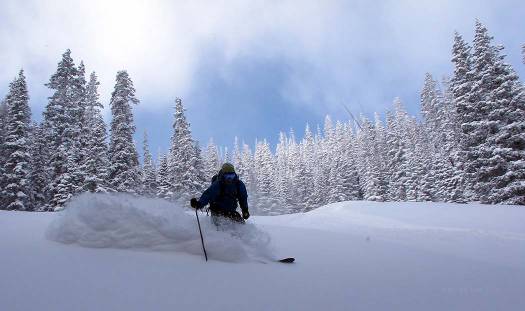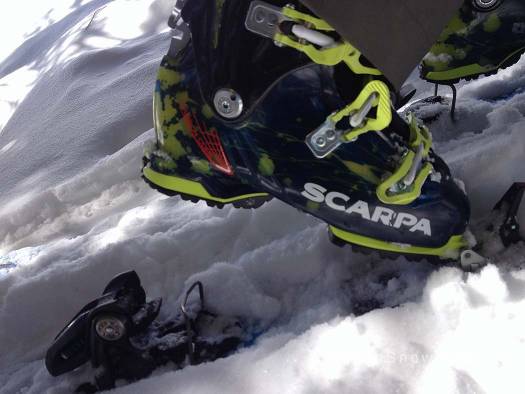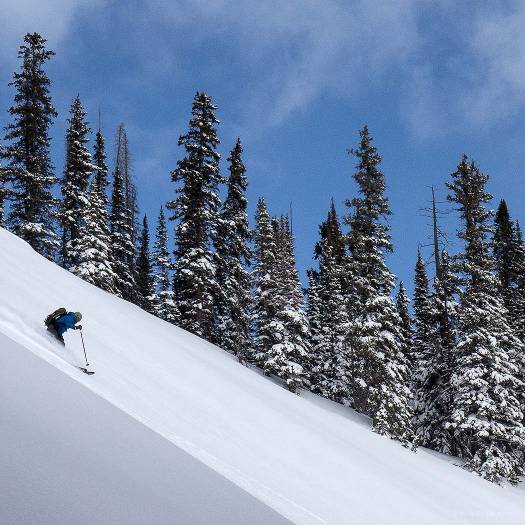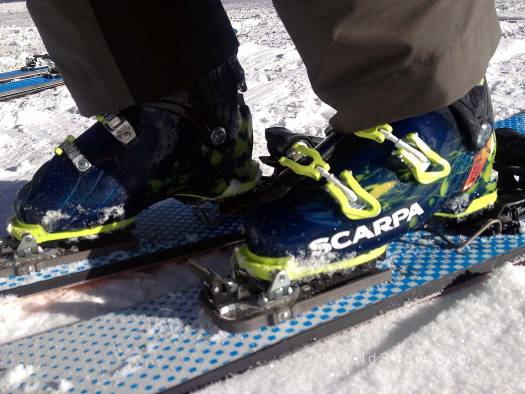Mark Zitelli
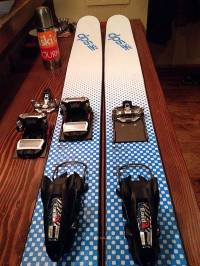
DPS Spoon, Cast and Dynafit toes. Marker Lord used for heel and alpine toe. Click images to enlarge.
My take on using DPS Spoons with the CAST system: I was surprised with how easy everything was. I was half expecting field use to be a pain after Lou and I found the installation to be a bit tedious due to screw length issues. Instead, CAST was user friendly once the shop work was done.
Putting the plates in and out took a little fidgeting (and by little I mean 5 seconds and only with the Marker plate) but once they were in, the shop sessions and hardware store trips were an afterthought.
(Note, for a detailed look at how this system works, please see our previous CAST post.)
Having a big ski like this with tech touring function is amazing for the uphill. I have been struggling with my Moment Comis and Marker F12’s for two years now. Every time I tour with them I have serious knee pain from the way the binding pivots (frankenstride) combined with lifting weight, but CAST combined with Dynafit toe totally took care of that and the weight of the Lord heel piece didn’t feel like it made much difference.
The hidden penalty of frame touring bindings is you lift the binding up with each step; CAST eliminates that, so perhaps that’s why it felt better than expected. Nonetheless, know that the main purpose of CAST is to allow skiing downhill with a full alpine binding while touring with a tech toe. The weight savings is a byproduct and varies according to which alpine binding you use with the system, as the alpine binding heel unit remains on the ski while you climb.
The up track in Marble, Colorado was nothing more than some dust on crust and even when kicking the edges into side hill, I couldn’t tell there was a touch of play with the plates. Overall, they were super solid on the uphill and as soon as I clicked in for the downhill they felt locked and loaded.
The Spoons were a total trip as well. As soon as I clicked in for the uphill, I was driving an Airbus A380. They were light and agile with a great swing weight, but they are huge, blowing out the sides of the skin track like a bulldozer. Because the rocker is so dramatic, combined with slight forward positioning of the Dynafit binding I needed to back weight the heel a little to get the proper purchase on the snow. Typically I can lead with my nose on the steep up-track, but with these it felt much more like leading with the naval so I wouldn’t slip back. It certainly wasn’t the fastest I have skinned up, but I would say it still beat the Comis.
The downhill took a couple laps to get a grasp for what the skis wanted to do. When I tipped the skis over the lip of the bowl, it was like the guy in Avitar trying to fly the dragon. Spoons just want to go FAST. These aren’t powder farming skis. They want big fast turns and even with the 6-7″ we found on the east side of the bowl, the fluff wasn’t slowing them down. As soon as my weight was a little back, it was full acceleration… and so much fun.
I have to say that I have been super impressed with the bindings and the system. It certainly isn’t foolproof, but I would recommend it over something like the Duke or even the lighter F12. Touring with the Dynafit toe piece makes all the difference in the world for me and while I haven’t tried to fidget with the bindings during some nasty stormy weather, some of the turns this weekend were getting a little wet and there does seem to be a little snow that gets in the plates while touring. I could see that being a problem if ice forms. I have been using a small flathead screwdriver to scrape the plate and slide the downhill bindings in. I’d say at most it adds one minute to a transition, but I don’t think anyone is racing on a ski with 148 underfoot.
Lou says that publishing weights of this system is like talking about the fuel economy of his Silverado 2500. Sure, in touring mode the increase in efficiency as compared to the same setup with a Duke or F12 is noticeable, and you don’t get that twisting stuff going on with sidehills. But in truth, rather than overall weight the added efficiency probably has more to do with the ergonomic toe pivot of a tech binding, as well as not lifting a frame binding each step. In other words, if you’re weight focused don’t lose sight of the main purpose for CAST: It allows you to tour with an efficient touring binding setup — and ski down with an alpine binding.
At any rate, we did get some current weights from the freeriders at CAST, per ski:
Look Pivot 18 alpine binding (lighter bindings are available), 1250g stock without cast (2500g per pair).
CAST with the alpine components, 1480g (2960g per pair) which would be a difference of 230g per ski.
CASt with Dynafit Speed Radical toe and Look heel components 1135g .
Beyond our regular guest bloggers who have their own profiles, some of our one-timers end up being categorized under this generic profile. Once they do a few posts, we build a category. In any case, we sure appreciate ALL the WildSnow guest bloggers!

